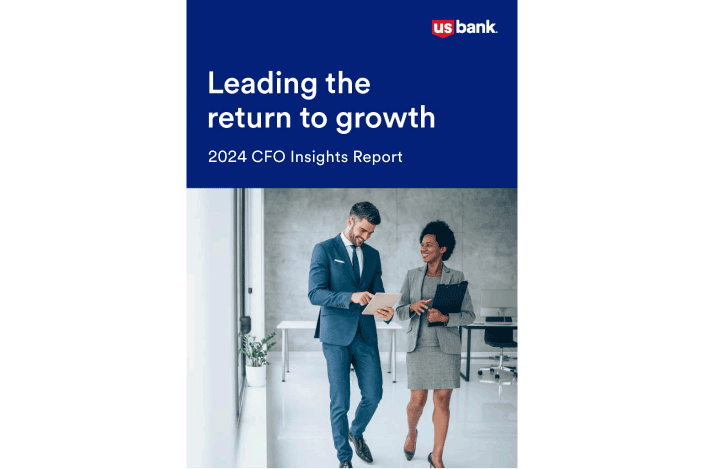Soft landing achieved?
The U.S. economy has been performing better than many people expected just a couple of years ago. A post-pandemic spike in demand, supply chain challenges, geopolitical shocks, and labor shortages raised inflation rates significantly and sparked a long series of interest-rate increases through 2022 and 2023. But the U.S. avoided the recession feared by some analysts. Recent economic news and data have revealed solid performance, built on strong business demand, robust consumer spending, a buoyant labor market, and a background of falling inflation. The economy appears on course for the ‘soft landing’ targeted by policymakers.
Yet a new U.S. Bank survey of 2,030 finance executives suggests that, while most are positive about the long-term outlook, there remains a significant degree of caution around the immediate prospects for the economy, as businesses grapple with ongoing challenges including the elevated cost of borrowing.
Below, we look at the tailwinds for this improved U.S. economic performance and speculate as to how things could play out in the coming months.
The recent economic performance has solid foundations.
Economic news headlines have been largely positive – and when you look closer at some of the underlying factors, the situation looks even more encouraging.
U.S. real GDP growth for 2023 was 2.5%, up from 1.9% in 2022. The figure for the first half of 2024 was a little more moderate, averaging 2%, but still encouraging, with U.S. Bank expecting U.S. growth to reach 2.5% for 2024.
We have identified four key factors behind this upturn.
1. Business demand has held up.
Important areas of business that looked vulnerable to a downturn have held up well, including manufacturing. Despite higher prices and borrowing costs, production orders stayed firm. In some sectors, demand eased off a little but this is consistent with the intention of the Federal Reserve to manage inflation gently downward.
2. Consumer spending has been strong.
The second surprise of the past 18 months has been that consumer spending has stayed very steady. High levels of employment have benefited consumers, many of whom have been able to draw on savings built up during COVID-19 lockdowns, cushioning them from the effects of higher inflation and interest rates. Inflation-adjusted consumer spending growth averaged a sturdy 2.6% annualized over the past 12 months.
3. The labor market is slowing, but only gradually.
The jobs market over the past two years has rarely been stronger. In fact, talent shortages remain a concern for many employers. Recent data has pointed to some easing off in this phenomenon but, again, this has been gradual. The number of layoffs remains low. Again, this is aligned with the Fed’s preferred trajectory. Increased immigration, boosting labor supply and reducing inflationary pressures, has also supported the labor market.
4. Inflation fever has broken.
It now looks clear that the U.S. economy has passed the height of the inflation crisis. Whether you use the Consumer Price Index (CPI) or the Personal Consumption Expenditures (PCE) index preferred by the Fed, its target of 2% is within sight. There has even been outright deflation in certain goods. Yet CPI remained stubbornly above the target range in the first half of 2024, in part because services inflation proved stickier than the overall figure, preventing the Fed from declaring mission accomplished.
Across the economy, then, what emerges is a picture of surprising strength. “We've seen the labor market come into better balance, with steady growth and overall activity holding up and inflation coming down. Few people thought that this was possible. We’ve rarely seen this type of dynamic before,” says Matt Schoeppner, senior economist at U.S. Bank.
Real GDP growth
“Despite some more recent softening in labor demand, I am still more positive than negative about what’s going to happen to the U.S. economy during the next 12 months."
-Matt Schoeppner
Senior Economist, U.S. Bank
Despite the recent upturn, businesses remain cautious.
Our survey of 2,030 U.S. finance leaders, conducted in January and February 2024, finds strong optimism about the long-term outlook: 58% are positive and just 15% negative about the next three years. However, in the near term, caution persists, with just 37% positive about the next 12 months and 33% negative.
The current priorities of finance leaders reflect this short-term wariness. Just 24% say their priority is driving revenue growth, compared with 37% who are focused on cutting costs across the business. Of those, 47% plan to cut costs by deploying technology, while a third (33%) expect to restructure their workforces. However, only 21% expect to make job cuts, slightly more than a year ago (19%).
Just 24% of the finance leaders are prioritizing revenue growth.
37% of finance leaders are focused on cutting costs across the business.
Those priorities reflect leaders’ assessments of the risks facing their business. While the number of leaders concerned by high inflation has dropped from 38% a year ago to 25%, 24% still say high interest rates are a worry, slightly up from last year (23%).
It’s little wonder that business is still concerned about interest rates, since the Fed has been clear that it will not rush into rate cuts and, when it does, they are likely to be gradual. “It’s not guaranteed that the Fed will cut rates at consecutive meetings,” says Schoeppner. “It’s still possible that it will make an initial cut and allow some time to see how it plays out in the economy before making further moves.”
That is a critical factor for business, as it will take time for the cost of long-term borrowing to reflect the effects of rate cuts. It’s understandable that finance executives remain sensitive to the impact of high rates. There are other potential economic risks to growth to consider as well, including the potential impact of high rates and prices on consumer spending.
Beyond current wariness lies a brighter longer-term economic outlook.
“Despite some more recent softening in labor demand, I am still more positive than negative about what’s going to happen to the U.S. economy during the next 12 months,” states Schoeppner. “We expect positive economic growth and put the chance of recession at only 25‒30%, which is about half of the probability at this point last year.”
Many finance executives will remain cautious until interest rates are firmly on a downward trajectory. Yet the experience of the past 12 months suggests that business can still feel positive about the prospects for the U.S. economy through 2024 and beyond.

Finance leaders voice their views in our 2024 CFO Insights Survey.
More than 2,000 finance leaders from companies across industries and across the nation told us what they’re focused on as they manage their businesses in today’s dynamic environment. From cutting costs to exploring AI to transforming their payments practices, the respondents have a lot on their plates. Use their insights to inform your own leadership approach.
More insights from our research

California report
What are California’s finance leaders focused on?

Payments Insights
What is driving payments transformation?

Digital Transformation
Leaders seek accelerated digital transformation.

Healthcare Report

